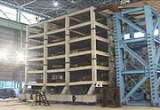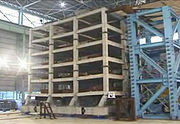
Earthquake simulation
Encyclopedia

Dynamic experiments on building and non-building structures may be physical – as with shake-table testing
Earthquake shaking table
There are several different experimental techniques that can be used to test the response of structures to verify their seismic performance, one of which is the use of an earthquake shaking table...
– or virtual (based on computer simulation). In all cases, to verify a structure's expected seismic performance, researchers prefer to deal with so called 'real time-histories' though the last cannot be 'real' for a hypothetical earthquake specified by either a building code
Building code
A building code, or building control, is a set of rules that specify the minimum acceptable level of safety for constructed objects such as buildings and nonbuilding structures. The main purpose of building codes are to protect public health, safety and general welfare as they relate to the...
or by some particular research requirements.
Shake-table testing
The best way to do it is to put the structure on a shake-tableEarthquake shaking table
There are several different experimental techniques that can be used to test the response of structures to verify their seismic performance, one of which is the use of an earthquake shaking table...
that simulates the seismic loading
Seismic loading
Seismic loading is one of the basic concepts of earthquake engineering which means application of an earthquake-generated agitation to a structure...
and watch what may happen next (if you have no time to stand out in the field and wait for a real earthquake to strike, of course). The earliest such experiments were performed more than a century ago
Computational approaches
Another way is to evaluate the earthquake performance analytically.The very first earthquake simulations were performed by statically applying some horizontal inertia forces, based on scaled peak ground acceleration
Peak ground acceleration
Peak ground acceleration is a measure of earthquake acceleration on the ground and an important input parameter for earthquake engineering, also known as the design basis earthquake ground motion...
s, to a mathematical model of a building . With the further development of computational technologies, static
Statics
Statics is the branch of mechanics concerned with the analysis of loads on physical systems in static equilibrium, that is, in a state where the relative positions of subsystems do not vary over time, or where components and structures are at a constant velocity...
approaches began to give way to dynamic
Dynamics (mechanics)
In the field of physics, the study of the causes of motion and changes in motion is dynamics. In other words the study of forces and why objects are in motion. Dynamics includes the study of the effect of torques on motion...
ones .
Traditionally, numerical simulation and physical tests have been uncoupled and performed separately. So-called hybrid testing systems employ rapid, parallel analyses using both physical and computational testshttp://nees.colorado.edu.

